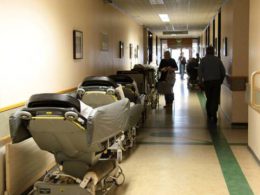New “trolley watch” figures released by the Irish Nurses & Midwives Organisation (INMO) show that on 20 January, over 500 patients had the “luxury” of occupying a hospital trolley, breaking the previous record of 495 reached in 2006. And while the corridors remain crammed with trolleys, outgoing HSE Chief, Brendan Drumm, would like to leave us a parting gift of cutting 1,100 beds in acute hospitals, on top of the closure of 900 acute beds in 2009.
In contrast to Brendan Drumm’s claims that we have far too many acute hospital beds, a recent report by the OECD, “Health at a Glance 2009”, places Ireland at the bottom of the list when it comes to acute beds, with an average of 2.7 beds per 1,000 people compared to an EU average of 3.8 per 1,000. In 2009, 272,000 bed days were lost through discharge delays and over 85% of patients who were delayed were over 65 years of age – a direct consequence of years of underinvestment in convalescence and nursing homes. With nowhere else to go, many elderly people have no choice but to remain in acute hospital care.
While budget cuts have led to bed closures in some parts of the health service, they’ve shut down elective surgery in other areas. A recent letter by Peter O’Rourke, an orthopaedic surgeon in Letterkenny General Hospital revealed that he has “nothing to do” as elective procedures have been postponed as a result of budgetary over-runs. At the same time, 230 children have spent more than 12 months on waiting lists for surgery. In Crumlin Children’s Hospital, there has been a 16% increase in the number of children on the surgical waiting list since April 2009.
The crisis in the health system is still here and the €1.3 billion in cuts to the health budget will only make the crisis worse. The recruitment bans which have been in place in order to cut costs will result in the loss of 3,700 staff by the end of 2010 which could lead to further understaffing in key areas. Fundamental change is needed in the health system.
The strategy of the HSE Executive and the government to cut costs and resources will only lead to the further destruction of our health system and put lives at risk. A genuine public health service requires a massive investment of funds to reduce waiting lists and to provide community-based primary care which will cut across unnecessary hospital visits and over-crowding but that is only possible if we based our health system on people’s needs and not on profits.











